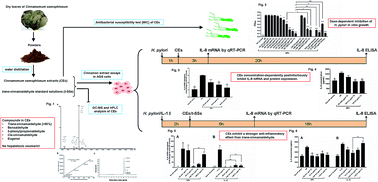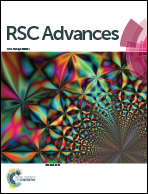Cinnamomum osmophloeum extracts inhibit growth of Helicobacter pylori and postinfectious interleukin-8 expression in human gastric epithelial cells
Abstract
Essential oils from leaves of Taiwan's indigenous cinnamon, Cinnamomum osmophloeum extracts (CEs), contain similar constituents to those of commercial cinnamons from dried barks of other Cinnamomum species. However, cinnamon bark extracts showed controversial in vitro and in vivo results in their antibacterial activities against H. pylori. Whether CEs inhibit H. pylori growth and inflammation of H. pylori-infected gastric epithelium is unknown. In this study, we used 4 h water distillation to obtain CEs, which comprised >95% trans-cinnamaldehyde and other 4 minor compounds that were confirmed by GC-MS and contained 1305.5 μg ml−1 of trans-cinnamaldehyde that was quantified by HPLC analysis. The minimal inhibitory concentration of trans-cinnamaldehyde in CEs against H. pylori was 40.8 μg ml−1 in 48 h co-cultures. We subsequently performed 2 cinnamon extract assays: 3 h treatment of CEs containing 6.3 μg ml−1 and 63 μg ml−1 of trans-cinnamaldehyde significantly inhibited IL-8 mRNA and protein expression in the 1 hour H. pylori-infected cells, whereas 6 h treatment of CEs containing 21 μg ml−1 of trans-cinnamaldehyde, but not CEs containing 10.5 μg ml−1 of trans-cinnamaldehyde, substantially downregulated IL-8 mRNA expression and these two CEs strongly suppressed IL-8 protein secretion in the 2 h H. pylori-infected cells. In the 2 h IL-1β-treated cells, both CEs and t-SSs containing 21 μg ml−1 and 10.5 μg ml−1 of trans-cinnamaldehyde for 6 h markedly downregulated IL-8 mRNA expression; CEs inhibited IL-8 protein production more potently than t-SSs when both contained the same concentration of trans-cinnamaldehyde at 21 μg ml−1. In conclusion, CEs concentration-dependently inhibit H. pylori growth and postinfectiously inhibit IL-8 mRNA and protein expression in H. pylori- and IL-1β-pretreated AGS cells. Moreover, CEs exhibited a stronger anti-inflammatory effect than trans-cinnamaldehyde, indicating that CEs can potentially be used to treat H. pylori infection.



 Please wait while we load your content...
Please wait while we load your content...